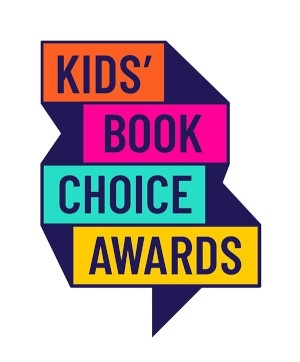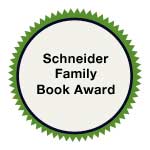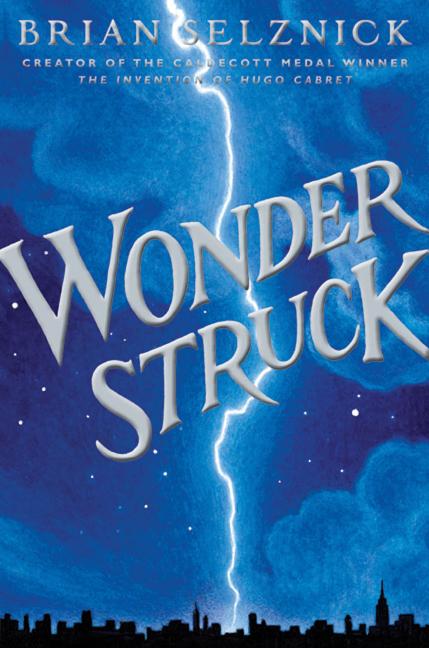
Book Resume
for Wonderstruck by Brian Selznick
Professional book information and credentials for Wonderstruck.
7 Professional Reviews (3 Starred)
7 Book Awards
Selected for 42 State/Province Lists
See full Book Resume
on TeachingBooks
As he did in The Invention of Hugo Cabret (Scholastic Press, 2007), Brian ...read more
- School Library Journal:
- Grades 4 - 8
- Booklist:
- Grades 4 - 8
- Publisher's Weekly:
- Ages 9 and up
- Kirkus:
- Ages 9 and up
- TeachingBooks:*
- Grades 3-12
- Word Count:
- 26,125
- Lexile Level:
- 830L
- ATOS Reading Level:
- 5.4
- Cultural Experience:
- Disability
- Genre:
- Mystery
- Year Published:
- 2011
22 Subject Headings
The following 22 subject headings were determined by the U.S. Library of Congress and the Book Industry Study Group (BISAC) to reveal themes from the content of this book (Wonderstruck).
- Museums--Fiction
- 20th century
- New York (N.Y.)--History--20th century--Fiction
- Diorama
- American Museum of Natural History--Fiction
- American Museum of Natural History
- Children's Books/Ages 9-12 Fiction
- Runaways--Fiction
- Diorama--Fiction
- People with disabilities--Fiction
- Runaway children
- Deaf--Fiction
- Juvenile Fiction | Mysteries, Espionage, & Detective Stories
- Deaf
- Runaways
- History
- Juvenile Fiction | Historical | General
- Families
- Families--Fiction
- New York (N.Y.)
- People with disabilities
- Museums
7 Full Professional Reviews (3 Starred)
The following unabridged reviews are made available under license from their respective rights holders and publishers. Reviews may be used for educational purposes consistent with the fair use doctrine in your jurisdiction, and may not be reproduced or repurposed without permission from the rights holders.
Note: This section may include reviews for related titles (e.g., same author, series, or related edition).
From Cooperative Children's Book Center (CCBC)
As he did in The Invention of Hugo Cabret (Scholastic Press, 2007), Brian Selznick again alternates prose and visual storytelling, in this case weaving two compelling tales into a satisfying whole. In 1977, Ben finds clues to the identity of the father he’s never known that lead him to New York City and the American Museum of Natural History. For Ben, who was born deaf in one ear and has recently lost his hearing in the other, running away from his relatives in Minnesota is more than a search for his father; it’s also a search for meaningful connection missing since his mother’s death. In 1927, Rose is growing up in a wealthy home in New Jersey. She is deaf and defiantly resists her father’s demands that she learn to lip-read and speak. Deeply unhappy, she runs away to New York City to see her mother, a silent film star with little interest in Rose. After her mother’s rejection, Rose goes to the American Museum of Natural History, where her older brother works. Fifty years later, Ben has found shelter and help at the Museum thanks to Jamie, a lonely boy whose father works there. He also begins to find answers about his father—an artist who worked for the museum—in the exhibits and in the files he explores with Jamie’s help. Those answers ultimately connect Ben and Rose in this story that has elements of mystery while offering insight into both friendship and family. Ben’s story is told almost entirely through prose, while Rose’s unfolds in detailed, dramatic pencil drawings. As the two stories merge, so too do the two narrative mediums. (Ages 8–13)
CCBC Choices 2012 © Cooperative Children's Book Center, Univ. of Wisconsin - Madison, 2012. Used with permission.
From Horn Book
January 1, 2012
Pictures follow a girl, Rose, in 1927; the text is set in 1977 where a boy, Ben, struggles with hearing loss. The two eventually meet: as an adult, Rose works at New York's Museum of Natural History, where Ben also finds himself. Ben's story suffers from an excess of telling rather than showing; nevertheless, there is much technical brilliance and genuine heart here.
(Copyright 2012 by The Horn Book, Incorporated, Boston. All rights reserved.)
From Horn Book
September 1, 2011
With Wonderstruck's opening wordless sequence of an approaching wolf, readers might think they've embarked upon a Gary Paulsen novel, but this is a story not of wilderness adventure but of two young people running -- to New York City -- for their lives. The pictures (pencil, double-page spread, wordless) follow a young girl, Rose, living in material comfort but also emotional distress in 1927 Hoboken; the text is set in 1977 in Minnesota's Boundary Waters region, where a boy, Ben, struggles with the death of his mother and the loss of his hearing. Yes, Rose and Ben eventually meet, as do the text and pictures, but both stories are encumbered by the conclusion of the book, which, in resolving many themes and mysteries, dictates too much of what has gone before -- it feels as if the narrative was composed backward rather than arising organically from its beginnings. For example, Rose's childhood hobby of constructing model buildings from the pages of hated books doesn't seem to follow from anything, but it does give her an adult career at New York's Museum of Natural History, where Ben also finds himself after several similarly belabored circumstances. Still, there is much technical brilliance here, both in the segues between text and pictures and between the pictures themselves, as in a scene where Rose, locked in a room, seems to be contemplating the many photographs on a wall, but a page turn reveals that Rose has actually spotted a window -- and escapes. While Ben's story suffers from an excess of telling rather than showing, he (Rose, too) is openhearted and easy to love. The intricate puzzle-solving of the plot gets a generous and welcome shot of straightforward emotion when Ben is given an unabashedly romantic friendship with another boy, Jamie, with whom he experiences the wonders of the museum in secret and at night, a nod to E. L. Konigsburg that Selznick acknowledges in an informative closing note. roger sutton
(Copyright 2011 by The Horn Book, Incorporated, Boston. All rights reserved.)
From School Library Journal
Starred review from August 1, 2011
Gr 4-8-Using the format he so brilliantly introduced in The Invention of Hugo Cabret (Scholastic, 2007), Selznick tells two parallel stories. The first, taking place in 1977, is told through words. Ben Wilson lives in Gunflint, MN. His mother has just died, and he doesn't know the whereabouts of his father. Disaster ensues when Ben is struck by lightning and loses the hearing in his one good ear. He runs away from his aunt and uncle and goes in search of his father. Parallel to Ben's story, and told through illustrations, is the story of Rose, a deaf child who lives in Hoboken, NJ, in 1927, with her overbearing father. She lives in a room that feels more like a prison, where she keeps a scrapbook of her silent-film star mother and builds models of New York City. Both Ben and Rose escape to New York and are drawn to the American Museum of Natural History. It is there that they find the connections they are seeking. The way that the stories of Ben and Rose echo one another, and then finally connect, is a thing of wonder to behold. The dual text/illustration format is not a gimmick when used to tell the right stories; the combination provides an emotional experience that neither the words nor the illustrations could achieve on their own.-Tim Wadham, St. Louis County Library, MO
Copyright 2011 School Library Journal, LLC Used with permission.
From Booklist
Starred review from August 1, 2011
Grades 4-8 *Starred Review* Opening Selznick's new book is like opening a cabinet of wondersthe early museum display case filled with a nearly infinite variety of amazing things that is so central to this story. Following the Caldecott Medalwinning The Invention of Hugo Cabret (2007), Selznick offers another visual narrative, one that feels even better suited to his inventive style. The beautifully crafted structure includes two stories set 50 years apart. The first, set in 1977, is told in text and follows Ben, who is grieving the sudden loss of his mother when he stumbles upon clues that point to his father's identity. The second, told entirely in richly shaded pencil drawings, opens in 1927 as a young girl, Rose, gazes at a newspaper clipping. Rose is deaf, and Ben also loses his hearing, during a lightning strike. Both lonely children run away to New York City, and their parallel stories echo and reflect each other through nuanced details, which lead like a treasure map to a conjoined, deeply satisfying conclusion. Selznick plays with a plethora of interwoven themes, including deafness and silence, the ability to see and value the world, family, and the interconnectedness of life. Although the book is hefty, at more than 600 pages, the pace is nevertheless brisk, and the kid-appealing mystery propels the story. With appreciative nods to museums, libraries, and E. L. Konigsburg, Wonderstruck is a gift for the eye, mind, and heart.(Reprinted with permission of Booklist, copyright 2011, American Library Association.)
From Publisher's Weekly
Starred review from July 18, 2011
Selznick follows his Caldecott-winning The Invention of Hugo Cabret with another illustrated novel that should cement his reputation as one of the most innovative storytellers at work today. Ben and Rose are both hearing-impaired. He is 12 in 1977; she is the same age 50 years earlier. Selznick tells their story in prose and pictures beginning with Ben, living (unhappily) with his aunt and uncle, 83 steps from the Minnesota lake cabin he shared with his librarian mother until her death in a car accident three months earlier. He has never met his father, but has reason to believe he may live in New York. As in Hugo Cabret, a significant part of the story is told in sequential illustrations, most of which depict the even unhappier Rose, whose movie star mother has remarried, leaving her daughter with her ex-husband in New Jersey. Both children run away to Manhattan seeking something from their respective absent parents. It takes several hundred pages and a big chunk of exposition to connect these two strands, but they converge in an emotionally satisfying way. Selznick masterfully uses pencil and paper like a camera, starting a sequence with a wide shot and zooming in on details on successive pages. Key scenes occur when the runaways find themselves in one of Manhattan's storied museums, and with one character named Jamie, and Rose's surname being Kincaid, it's impossible not to think of E.L. Konigsburg's From the Mixed-up Files of Mrs. Basil E. Frankweiler, to which Selznick tips his hat in an author's note. Like that Newbery winner, Selznick's story has the makings of a kid-pleasing classic. Ages 9â€Â"up.
From Kirkus
July 1, 2011
Brian Selznick didn't have to do it.
He didn't have to return to the groundbreaking pictures-and-text format that stunned the children's-book world in 2007 and won him an unlikely—though entirely deserved—Caldecott medal for The Invention of Hugo Cabret. Weighing in at about two pounds, the 500-plus page tome combined textual and visual storytelling in a way no one had quite seen before.
In a world where the new becomes old in the blink of an eye, Selznick could have honorably rested on his laurels and returned to the standard 32-to-48–page picture-book format he has already mastered. He didn't have to try to top himself.
But he has.
If Hugo Cabret was a risky experiment that succeeded beyond Selznick and publisher Scholastic's wildest dreams (well, maybe not Scholastic's—they dream big), his follow-up, Wonderstruck, is a far riskier enterprise. In replicating the storytelling format of Hugo, Selznick begs comparisons that could easily find Wonderstruck wanting or just seem stale.
Like its predecessor, this self-described "novel in words and pictures" opens with a cinematic, multi-page, wordless black-and-white sequence: Two wolves lope through a wooded landscape, the illustrator's "camera" zooming in to the eye of one till readers are lost in its pupil. The scene changes abruptly, to Gunflint Lake, Minn., in 1977. Prose describes how Ben Wilson, age 12, wakes from a nightmare about wolves. He's three months an orphan, living with his aunt and cousins after his mother's death in an automobile accident; he never knew his father. Then the scene cuts again, to Hoboken in 1927. A sequence of Selznick's now-trademark densely crosshatched black-and-white drawings introduces readers to a girl, clearly lonely, who lives in an attic room that looks out at New York City and that is filled with movie-star memorabilia and models—scads of them—of the skyscrapers of New York.
Readers know that the two stories will converge, but Selznick keeps them guessing, cutting back and forth with expert precision. Both children leave their unhappy homes and head to New York City, Ben hoping to find his father and the girl also in search of family. The girl, readers learn, is deaf; her silent world is brilliantly evoked in wordless sequences, while Ben's story unfolds in prose. Both stories are equally immersive and impeccably paced.
The two threads come together at the American Museum of Natural History, Selznick's words and pictures communicating total exhilaration (and conscious homage to The Mixed-up Files of Mrs. Basil E. Frankweiler). Hugo brought the bygone excitement of silent movies to children; Wonderstruck shows them the thrilling possibilities of museums in a way Night at the Museum doesn't even bother to.
Visually stunning, completely compelling, Wonderstruck demonstrates a mastery and maturity that proves that, yes, lightning can strike twice. (Historical fiction. 9 & up)
(COPYRIGHT (2011) KIRKUS REVIEWS/NIELSEN BUSINESS MEDIA, INC. ALL RIGHTS RESERVED.)
7 Book Awards & Distinctions
Wonderstruck was recognized by committees of professional librarians and educators for the following book awards and distinctions.
 ALSC Notable Children's Books, 1995-2025, Commended, 2012
ALSC Notable Children's Books, 1995-2025, Commended, 2012
 Best Fiction for Young Adults, 2011-2024, Selection, 2012
Best Fiction for Young Adults, 2011-2024, Selection, 2012
 CCBC Choices, Selection, 2012
CCBC Choices, Selection, 2012
 Kids’ Book Choice Awards, 2008-2022, Illustrator Winner, 2012
Kids’ Book Choice Awards, 2008-2022, Illustrator Winner, 2012
 Schneider Family Book Award, 2004-2025, Winner, 2012
Schneider Family Book Award, 2004-2025, Winner, 2012
 Publishers Weekly Best Books, 2010-2024, Fiction Selection, 2011
Publishers Weekly Best Books, 2010-2024, Fiction Selection, 2011
 SLJ Best Books of the Year, 2010 - 2024, Selection, 2011
SLJ Best Books of the Year, 2010 - 2024, Selection, 2011
42 Selections for State & Provincial Recommended Reading Lists
Wonderstruck was selected by educational and library professionals to be included on the following state/provincial reading lists.
Canada Lists (3)
Alberta
- Edmonton Public Library Young Reader's Choice Award, 2014, for Junior Division
- Pacific Northwest Library Association Young Reader's Choice Award, 2014, Junior Division
British Columbia
- Pacific Northwest Library Association Young Reader's Choice Award, 2014, Junior Division
United States Lists (39)
Alabama
- Alabama Camellia Award, 2012-2013, Grades 4-6
Alaska
- Pacific Northwest Library Association Young Reader's Choice Award, 2014, Junior Division
California
- California Young Reader Medal, 2013-2014, Middle School/Junior High Division
Colorado
- 2013 Colorado Children's Book Award: Jr. Books
Delaware
- Blue Hen Book Award, 2014 -- Middle Readers
Idaho
- Pacific Northwest Library Association Young Reader's Choice Award, 2014, Junior Division
Illinois
- Bluestem Award, 2015, for Grades 3-5
Iowa
- Iowa Children's Choice Award, 2013-2014, Grades 3-6
Kansas
- William Allen White Award, 2013-2014, Grades 3-5
Kentucky
- 2013 Kentucky Bluegrass Award -- Upper Elementary
Louisiana
- Louisiana Young Readers' Choice Award, 2014, Grades 6-8
- Louisiana Believes ELA Guidebooks, Grade 5
Maine
- Maine Student Book Award, 2012-2013, Grades 4-8
Michigan
- Great Lakes Great Books Award, 2012-2013, Grades 4-5
- Mitten Award, 1999-2024, for Grades K-5
Missouri
- Mark Twain Readers Award, 2013-2014, Grades 4-6
Montana
- Pacific Northwest Library Association Young Reader's Choice Award, 2014, Junior Division
Nebraska
- Golden Sower Award, 2013-2014 -- Intermediate Book category
New Hampshire
- Great Stone Face Award, 2012-2013, Grades 4-6
New Jersey
- Garden State Children's Book Awards, 2014 -- Fiction
New Mexico
- 2013 New Mexico Battle of the Books for Elementary Schools
- New Mexico Battle of the Books for Elementary Schools, 2018, Grades 4-5
- New Mexico Battle of the Books for Middle Schools, 2014, Grades 7-9
New York
- On Your Mark, Get Set, Read! Summer Reading 2016, Tween
Ohio
- Buckeye Children's Book Award, 2012, Grades 3-5
Rhode Island
- 2013 Rhode Island Teen Book Award
- Rhode Island Children's Book Award, 2013, Grades 3-6
South Carolina
- SCASL Children's Book Awards, 2013-2014, Grades 3-6
South Dakota
- Young Adult Reading Program, 2012-2013 -- Middle School
Tennessee
- Volunteer State Book Awards, 2013-2014 -- Middle School Division
Texas
- 2012-2013 Bluebonnet Award Nominees
- Bluebonnet Award Nominees, 2012-2013
Vermont
- Dorothy Canfield Fisher Children's Book Award, 2012-2013, Grades 4-8
Virginia
- Virginia Readers' Choice, 2013-2014, Middle School
Washington
- Pacific Northwest Library Association Young Reader's Choice Award, 2014, Junior Division
Wisconsin
- 2013 Golden Archer Award -- Intermediate Category
- Battle of the Books, 2012-2013 -- Elementary Division
- Battle of the Books, 2018-2019 -- Elementary Division for Grades 4-6
Wyoming
- Indian Paintbrush Book Award, 2012-2013, Grades 4-6
Primary Source Statement on Creating Wonderstruck
Brian Selznick on creating Wonderstruck:
This primary source recording with Brian Selznick was created to provide readers insights directly from the book's creator into the backstory and making of this book.
Listen to this recording on TeachingBooks
Citation: Selznick, Brian. "Meet-the-Author Recording | Wonderstruck." TeachingBooks, https://lib.teachingbooks.net/bookResume/t/25731. Accessed 01 February, 2025.
Preview Digital Book
Explore Wonderstruck on Marketplace. Access requires OverDrive Marketplace login.
This Book Resume for Wonderstruck is compiled from TeachingBooks, a library of professional resources about children's and young adult books. This page may be shared for educational purposes and must include copyright information. Reviews are made available under license from their respective rights holders and publishers.
*Grade levels are determined by certified librarians utilizing editorial reviews and additional materials. Relevant age ranges vary depending on the learner, the setting, and the intended purpose of a book.
Retrieved from TeachingBooks on February 01, 2025. © 2001-2025 TeachingBooks.net, LLC. All rights reserved by rights holders.


